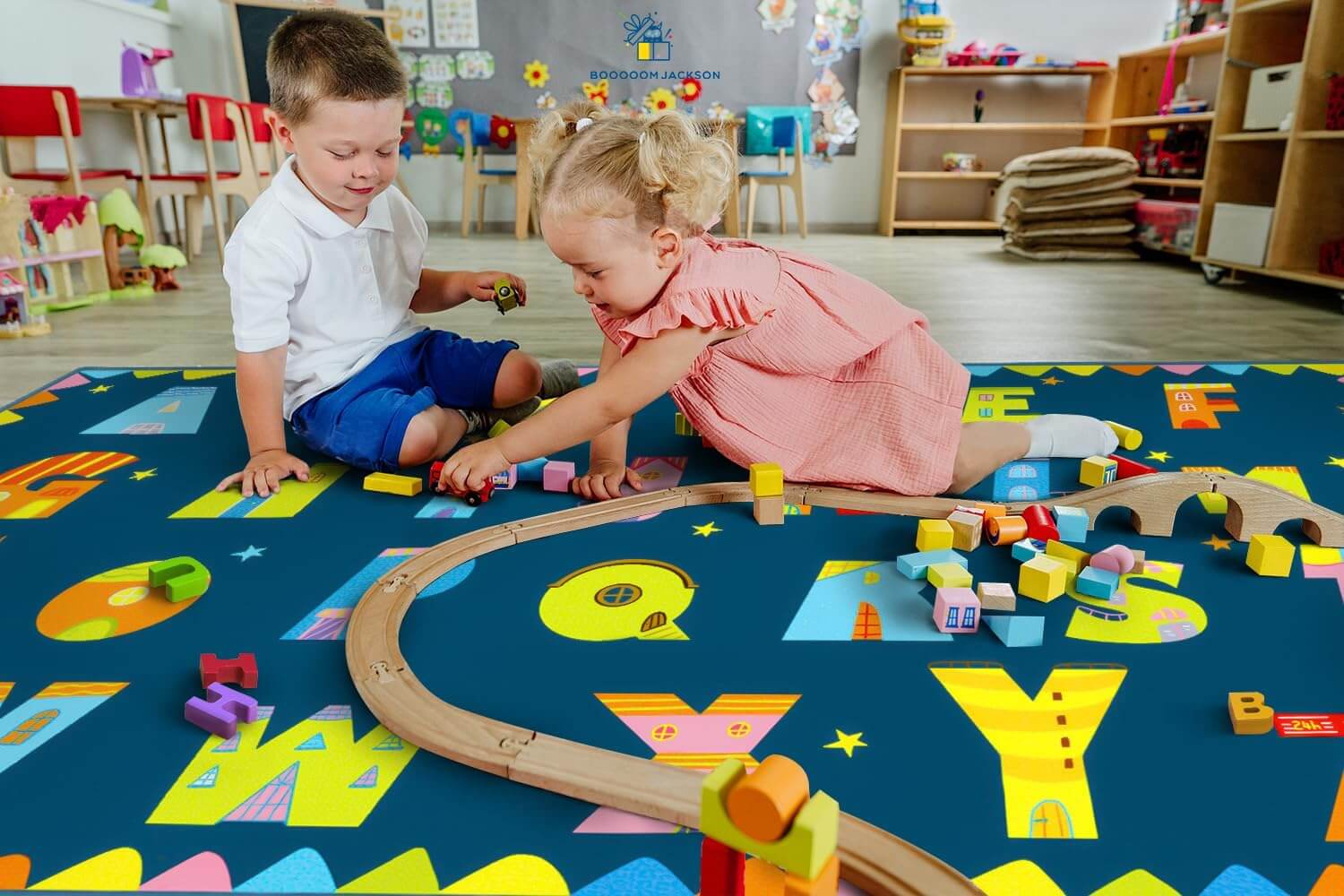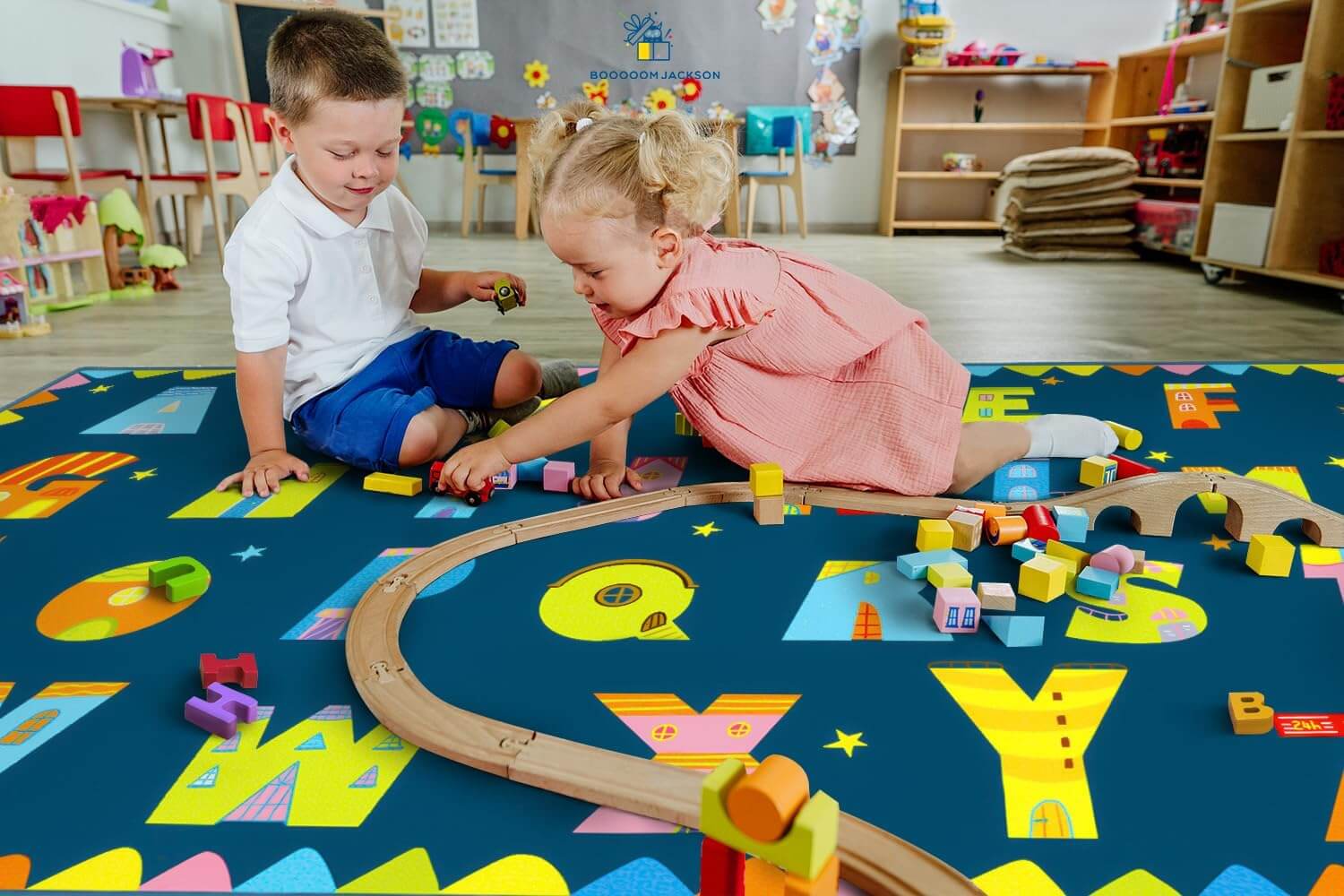Ever noticed how kiddos are naturally drawn to patterns? Whether they're arranging blocks in rainbow order or spotting shapes in clouds, children are pattern-seeking machines from day one! Now imagine harnessing that natural inclination by placing powerful pattern-learning tools right beneath their wiggling toes. That's right—your classroom carpet might just be the most underutilized math manipulative in the entire room!
At BooooomJackson, we've been diving deep into the fascinating connection between carpet patterns and cognitive development. What we've discovered will have you looking at your classroom floor in a whole new light!
Pattern Power: The Brain Science Behind the Magic
Before we roll out the specific patterns that pack the biggest cognitive punch, let's chat about why patterns matter so much to developing brains. According to developmental cognition researchers, pattern recognition isn't just a nice-to-have skill—it's fundamental to how we understand and navigate the world.
"Pattern recognition is essentially the foundation of all mathematical thinking," explains educational neuroscientist Dr. Maria Chen in her groundbreaking work on spatial reasoning in early childhood. "When children identify, extend, and create patterns, they're building the neural pathways that will later support algebraic thinking, geometry understanding, and even advanced calculus concepts."
In simpler terms—those repeating triangles on your classroom rug aren't just pretty; they're actually building mathematical brains!
Mathematical Minds in the Making: The Top Pattern Performers
Not all patterns are created equal when it comes to cognitive development. Let's explore the classroom carpet designs that research suggests offer the biggest brain boost:
1. Repeating Patterns: The Gateway to Algebraic Thinking
Simple repeating patterns (ABABAB or ABCABC sequences) form the building blocks of pattern recognition. These seemingly basic designs are actually developing something incredibly sophisticated—algebraic thinking!
"I never connected our rainbow stripe carpet to math until I watched my preschoolers predict what color would come next," shares Ms. Rodriguez from Sunshine Elementary. "They were doing early algebraic reasoning without even realizing it!"
According to early mathematics experts, children who regularly engage with repeating patterns develop stronger skills in:
- Prediction
- Logical reasoning
- Mathematical vocabulary
- Sequencing abilities
Teacher tip: Our BooooomJackson Rainbow Sequence Rugs feature gradually increasing pattern complexity to grow with your students—from simple AB patterns for the littlest learners to complex ABCDEF patterns for upper elementary algebraic thinking.
2. Geometric Patterns: Spatial Reasoning Superstars
Triangles and squares and hexagons, oh my! Geometric patterns do more than just pretty up your classroom—they're actively building spatial reasoning skills that correlate strongly with later STEM success.
Research published in the journal Developmental Psychology found that early spatial ability is a powerful predictor of achievement in mathematics, science, technology, and even art. The strongest connection? Exposure to varied geometric patterns!
Pattern in practice: "My first graders used to struggle with geometry vocabulary until we got our BooooomJackson Shape Sequence Carpet," explains Mr. Washington from Oakwood Elementary. "Now they spontaneously use words like 'vertex' and 'symmetry' during regular play—it's like they're speaking geometry as a second language!"
3. Fractal Patterns: Nature's Mathematics Underfoot
Ready for some serious pattern power? Fractal patterns—those fascinating designs where the same pattern repeats at different scales—might be the ultimate brain boosters.
According to research on cognition and natural patterns, fractal designs aren't just mathematically complex; they actually reduce stress while simultaneously engaging higher-order thinking skills!
"Our classroom used to get chaotic during transitions until we added our BooooomJackson Nature Fractal Rug," shares special education teacher Ms. Chen. "Something about those repeating natural patterns seems to both calm and focus my students—especially those with attention challenges."
4. Grid Patterns: Coordinate Plane Preparation
Don't underestimate the humble grid! These straightforward patterns lay the groundwork for everything from basic counting to complex coordinate geometry.
"I never realized how valuable our grid carpet was until I taught coordinates in fourth grade," admits veteran teacher Mr. Patel. "Students who had spent years playing on grid rugs in earlier grades intuitively understood the coordinate plane, while others struggled with the abstract concept."
Mathematics education researchers confirm that early exposure to grid patterns supports:
- Counting and cardinality
- Base-ten understanding
- Measurement concepts
- Coordinate geometry foundations
Pattern Play: Turning Carpet Designs into Learning Opportunities
Having the right patterns underfoot is just the beginning. The magic happens when teachers intentionally integrate these designs into everyday learning! Here are some teacher-tested strategies:
Morning Meeting Mathematics
Transform your daily gathering with pattern-focused questions:
- "Today I'm thinking of a shape on our carpet that has four equal sides..."
- "Can anyone point to a repeating pattern and tell us the rule?"
- "If we were going to extend this spiral pattern, what would come next?"
Transition Time Pattern Hunts
Make moving from one activity to another both orderly and educational:
- "When I call your table, find a hexagon on the carpet and stand on it"
- "Walk to line up by following the fibonacci spiral on our rug"
- "Freeze on a shape with exactly three sides when the music stops"
Literacy-Pattern Connections
Connect patterns to language development:
- Use carpet patterns to inspire pattern-based poetry
- Create stories where the characters move along the patterns
- Practice descriptive language by having students describe specific patterns to partners
As kindergarten teacher Ms. Taylor explains: "We play 'Pattern Detectives' where one student describes a pattern on our BooooomJackson Multi-Pattern Carpet while others try to find it. Their descriptive vocabulary has exploded since we started this game!"
The Just-Right Challenge: Matching Patterns to Developmental Stages
The most effective pattern-based learning happens when carpet designs align with developmental readiness. Early childhood pattern progression research suggests following this sequence:
For Preschool Pattern Explorers (Ages 3-4)
- Simple two-element repeating patterns (AB, AB, AB)
- Basic geometric shapes (circles, squares, triangles)
- High contrast colors to highlight pattern elements
For Kindergarten Pattern Inventors (Ages 5-6)
- Three- and four-element patterns (ABC, ABC or ABCD, ABCD)
- Growing patterns (1, 2, 3, 4...)
- Introduction to symmetrical designs
For Primary Grade Pattern Mathematicians (Ages 6-8)
- Complex repeating patterns (AABBC, AABBC)
- Grid patterns with coordinate possibilities
- Simple fractal designs
For Upper Elementary Pattern Theorists (Ages 8-11)
- Algebraic patterns with multiple attributes
- Geometric patterns featuring angle relationships
- Advanced fractal designs
As Ms. Rodriguez from Sunnyview Elementary points out: "Having different pattern complexity zones on our carpet means all my students can find their 'just-right' pattern challenge. My struggling learners build confidence with simpler patterns while my advanced students tackle the complex sections."
Beyond Recognition: Using Patterns for Creative and Critical Thinking
The ultimate goal isn't just pattern recognition—it's using patterns as tools for deeper thinking. Educational psychologists suggest these advanced pattern activities:
Pattern Extension Challenges
"What comes next?" activities develop prediction skills and logical reasoning.
Pattern Error Detection
"What's wrong with this pattern?" questions build analytical thinking.
Pattern Transformation Tasks
"How could we change this pattern?" prompts encourage creative thinking.
Pattern Creation Opportunities
"Can you create your own pattern using these rules?" fosters innovation.
Third-grade teacher Mr. Washington shares: "Our Friday 'Pattern Invention Convention' has students creating their own patterns on our blank grid section of the BooooomJackson Creator Carpet. The mathematical creativity I've seen is absolutely amazing—these kiddos are designing patterns I would never have thought of!"
Pattern Equity: Ensuring All Students Benefit
An important note: pattern recognition abilities develop at different rates, and cultural backgrounds influence pattern familiarity. Creating an equitable pattern-rich environment means:
- Offering patterns with varying complexity levels
- Connecting patterns to diverse cultural designs
- Providing multiple entry points to pattern activities
- Celebrating different approaches to pattern thinking
As multicultural mathematics education reminds us, patterns appear in every culture's art, architecture, and design. By incorporating diverse pattern traditions, we both validate students' backgrounds and expand everyone's pattern repertoire.
Patterned Pathways to Success: The Long-Term Benefits
The pattern-recognition skills developed through thoughtful interaction with classroom carpet designs extend far beyond elementary mathematics. Longitudinal research on early pattern skills suggests these abilities predict later success in:
- Advanced mathematics
- Computer programming
- Scientific research
- Music composition
- Architectural design
- Financial analysis
As Principal Taylor from Willowbrook Elementary observes: "We've been tracking student outcomes since implementing BooooomJackson Pattern-Progressive Carpets three years ago. The data is clear—classrooms using these carpets with intentional pattern activities show significantly stronger mathematical reasoning scores by third grade."
Small Investment, Enormous Returns
Perhaps the most beautiful thing about pattern-rich classroom carpets? They represent a one-time investment that yields years of cognitive dividends. Unlike many trendy educational tools, these pattern powerhouses work their brain-building magic every single day, without requiring extra teacher prep or special materials.
"If you're looking to maximize your classroom budget impact," advises veteran teacher Ms. Jackson, "invest in a high-quality pattern carpet. Unlike apps or workbooks that students quickly outgrow, a thoughtfully designed pattern carpet offers new learning opportunities year after year as students develop more sophisticated pattern understanding."
At BooooomJackson, we believe that something as simple as the patterns beneath little feet can shape mathematical minds for life. Because sometimes, the most powerful learning tools aren't flashy gadgets or expensive programs—they're the thoughtfully designed environments where children spend their days discovering the beautiful patterns that make up our mathematical world.




Leave a comment
This site is protected by hCaptcha and the hCaptcha Privacy Policy and Terms of Service apply.